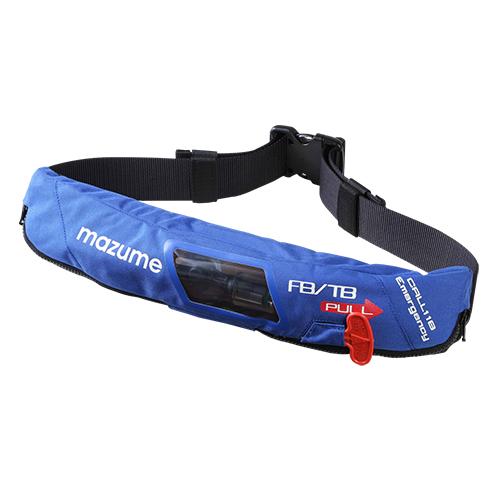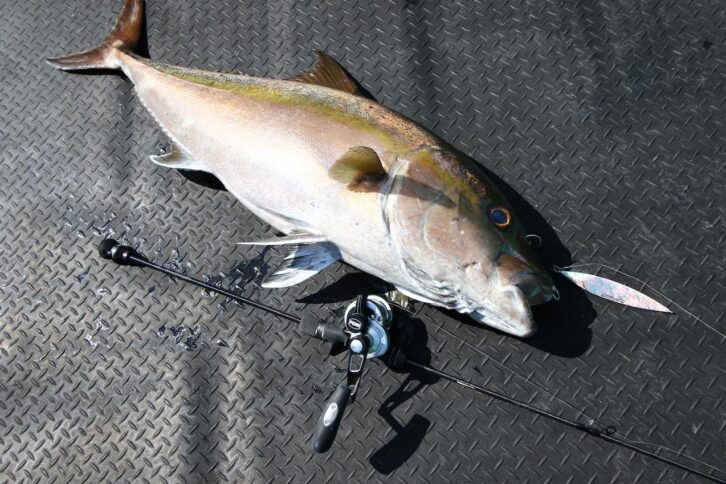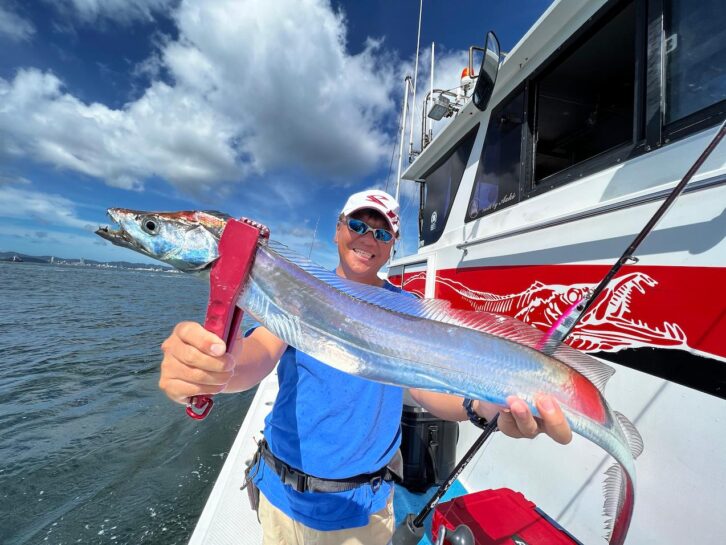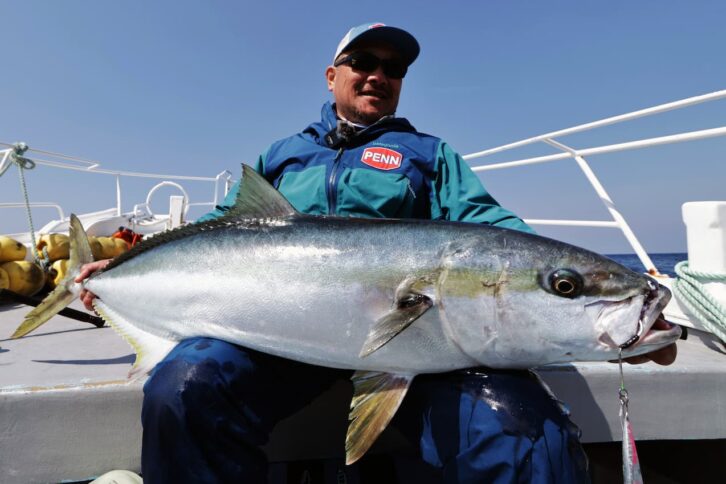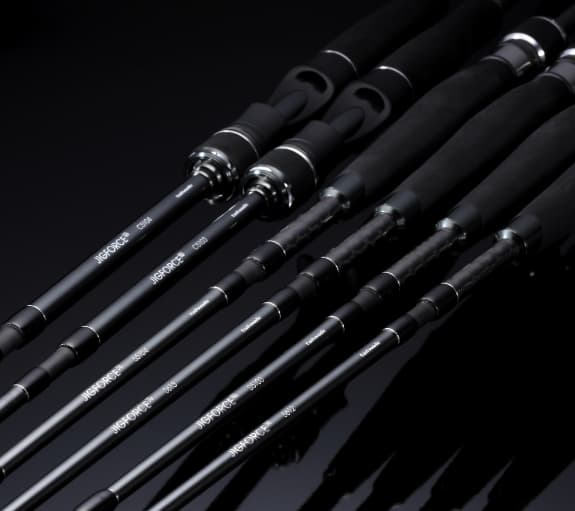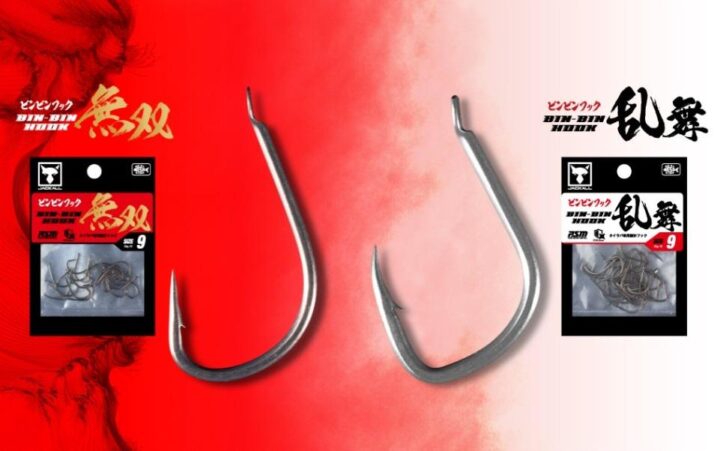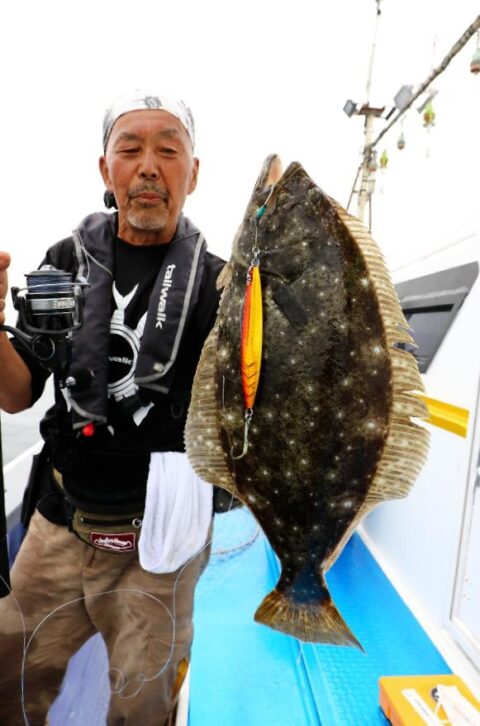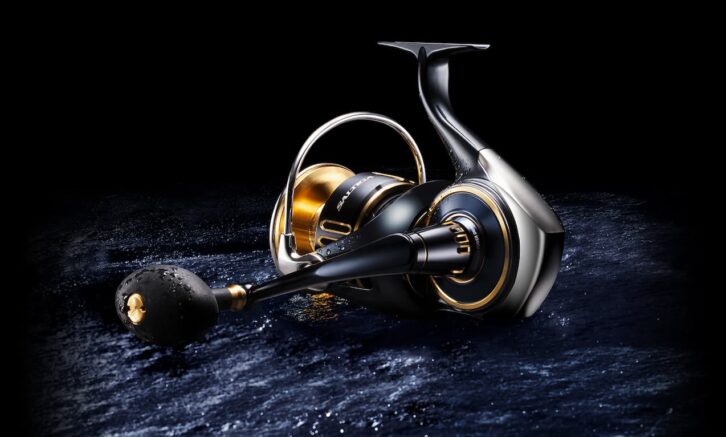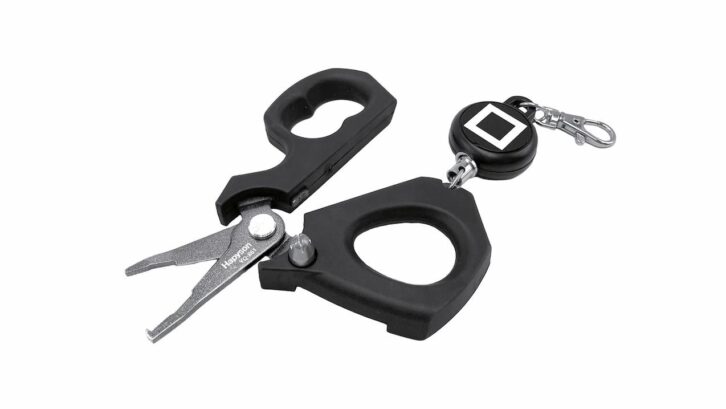Off the coast of Gumisaki, Fukui Prefecture
Aiming for deep-sea Spring Snapper!
The key to success is Tail Laba x Strong Wave Motion of Worm x Arrangement
Takeshi Ota, Naokazu Naka, Toshiyuki Tsui, and Ayuna Iga aka “Ayuchii” from Crazy Ocean Inc. visited the Ocean Queen in Gumisaki, Fukui Prefecture, for a photo shoot for Fishing Lover Tokai. This time, she is targeting the red sea bream, which have entered the nokkomi season. The main target was large sea bream in the deep sea, but there were also some happy guests on the trip, which made for a satisfying fishing experience. What was the key to the success?
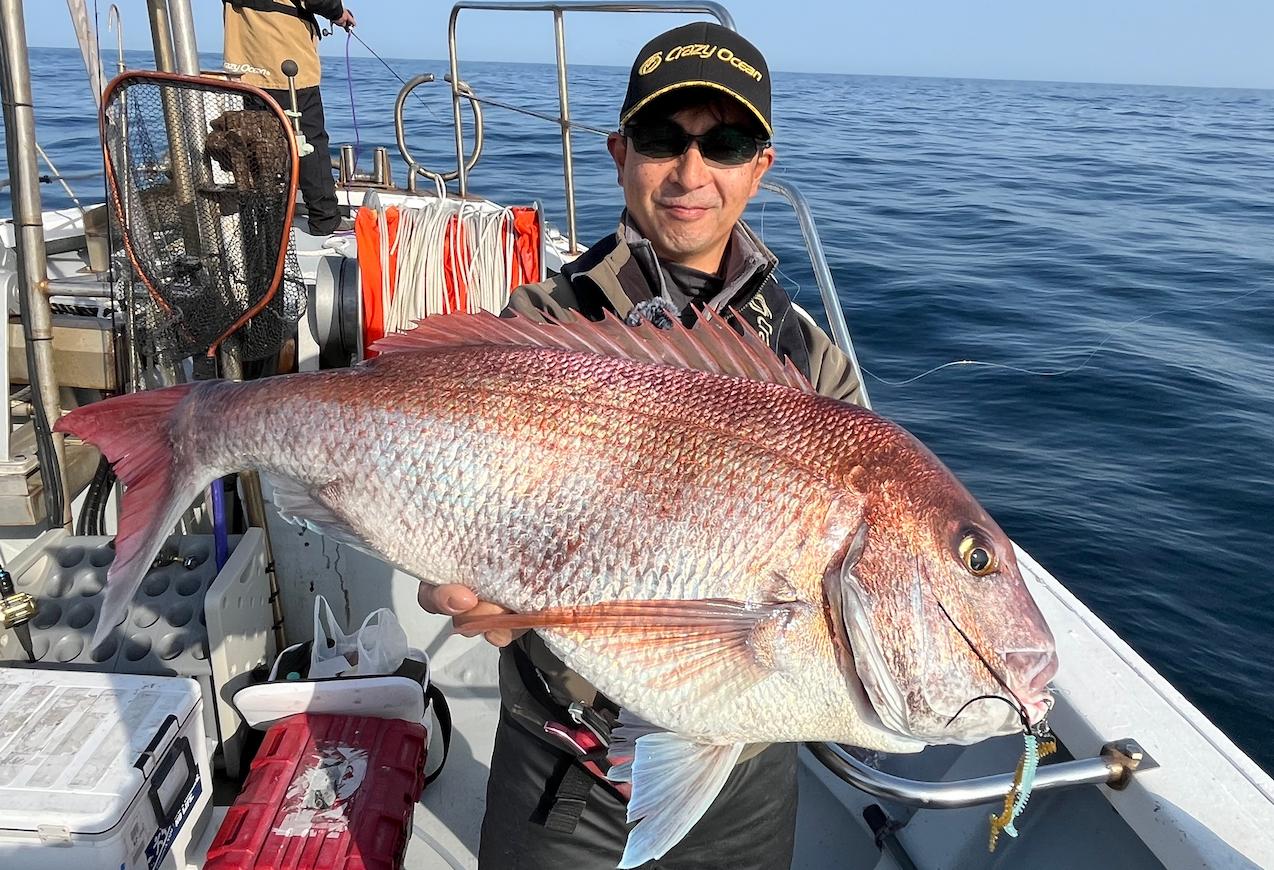
INDEX
A hit at the very beginning of the fishing season! Appealing with UMIKEMUSHI!
Spring is the season of bigeye snapper nokkomi in many areas, and tilefish fishing is booming in many places. In Gumisaki, Fukui Prefecture, fishing for red sea bream is also very active in April and May. Anticipating the start of the nokkomi season, the members of Crazy Ocean visited the Ocean Queen, a pleasure fishing boat in Gumisaki, Fukui Prefecture. On the day of the fishing trip, the mahi for nokkomi seemed to have just started, but we were informed that they were being caught in sporadic numbers. We planned to attack mainly the deeper areas of the river, hoping for a rough bite before the spawning season. How will the big sea bream react? The members of the team entered the fishing spot in the morning, expecting to catch fish in the morning midsummer, and immediately started to drop tilefish. We started at a depth of 106 meters.
A peek at the fish finder showed a reaction. Here, Mr. Naka explained that they would probe 30m to 40m from the bottom. He said that he would watch the reaction of the fish finder and probe to the top of the bait’s reaction. The basic method of exploring is to start reeling quickly as soon as the bait touches the bottom, and to continue reeling at a constant speed. He tried various reeling speeds. After a few times of raising and lowering the reel, Mr. Naka’s tilefish began to respond.
Mr. Naka’s tackle this time was a Crazy Ocean Ocean Ocean Sensor Tie-Lab B60V rod, No. 1 PE, and No. 6.0 flash leader. He selected a 150 g tie-lava head, because he wanted to fish deep, and attached a tropical orange color “Click-Tack Tie-Lava” tie and hook. He also attached two “UMIKEMUSHI CURLY” cream soda BL glow color and Shirasu star color to the hook. Umi Caterpillar Curly is a new product for 2024. It is an item that can be attached to tilefish hooks to add wave motion and increase their appeal. The glue-type color was selected to stand out because of the dark conditions during the midsummer time.
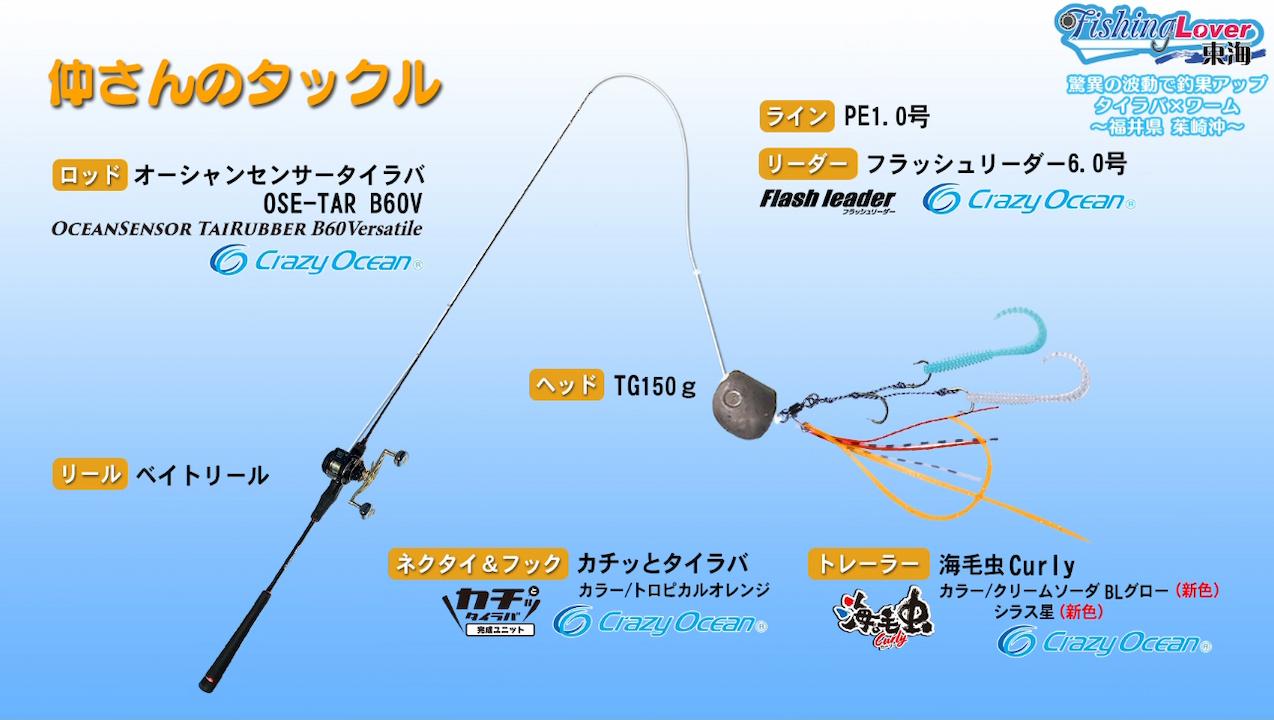
However, the first fish that hit Mr. Naka was immediately recognized as a blowfish by the way it pulled. He had a suspicious bite about 50 meters from the bottom, and when he focused on that area, he got a hit. The fish that came up was, as expected, a blowfish. But when Mr. Ota saw it, he said happily, “I did it! It’s my target,” he said happily. If cooked properly at a blowfish restaurant, it is a tasty target (*Pufferfish poison is dangerous. (*Pufferfish poison is dangerous, so please ask a qualified professional to dispose of your catch when you bring it home.)

Next, Mr. Ota also had a hit. He was bitten by the tropical orange color of the “Click TAIRABA,” the Shirasu star color of the UMIKEMUSHI CURLY, and the glow white color of the UMIKEMUSHI CURLY. However, he thought that a mahi-fugu, which he had been hoping to catch after seeing Mr. Naka’s catch, had come, but this one was a lenkodai. After this, Mr. Naka and Mr. Tsui also hit a Lenko Snapper. The appeal of the sea caterpillar curly seemed to be working.
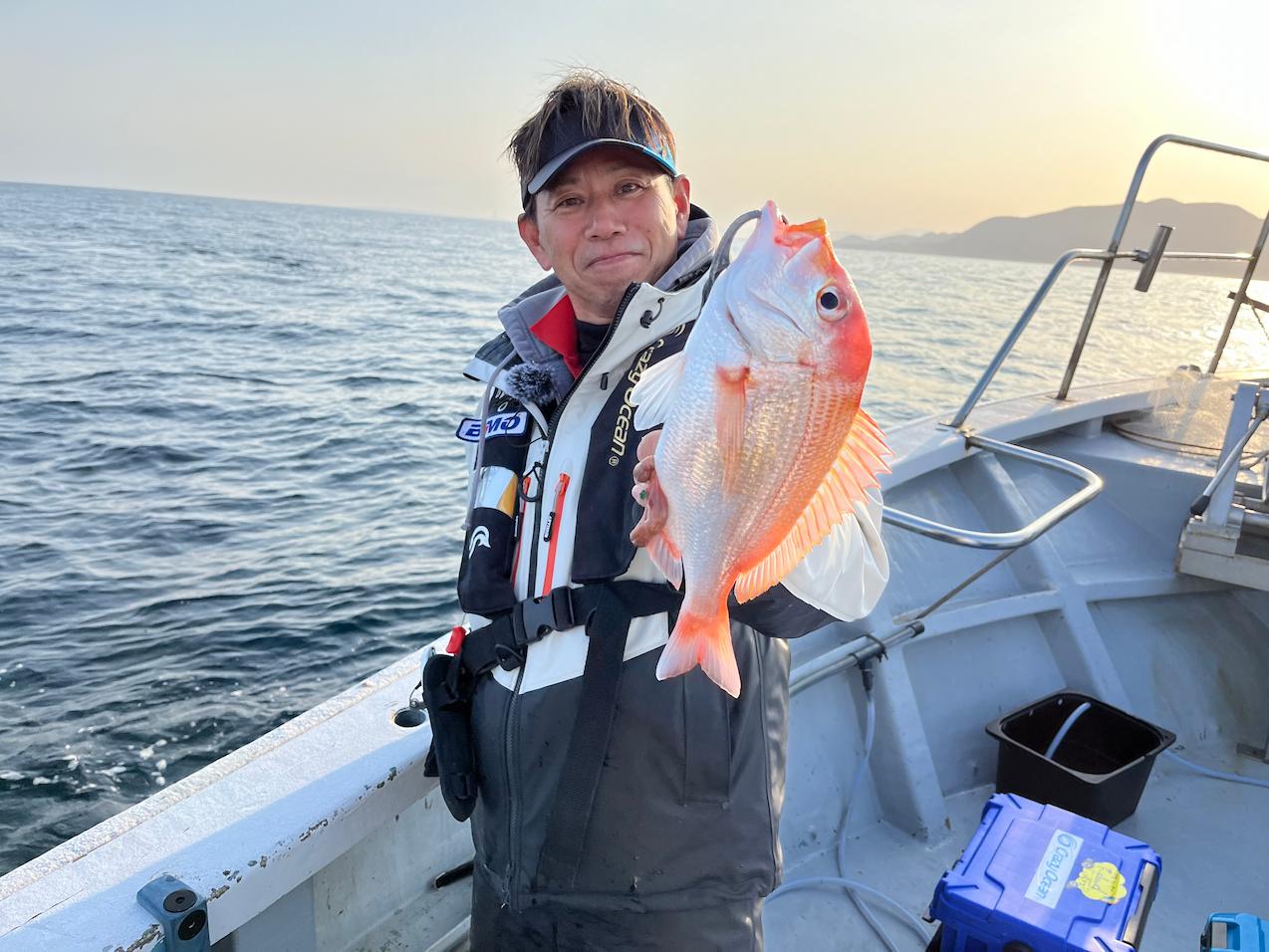
Easy tie change!
Incidentally, the “click tie rubbers” used by the members this time feature a one-touch tie change. This is very useful in fields where there are many blowfish and the ties are easily damaged. The ability to easily change ties also makes it much smoother to change ties in response to changes in the amount of light rays and the bait at the time. The hooks are also designed to be replaced with split rings, making it easy to change hooks after catching several fish.
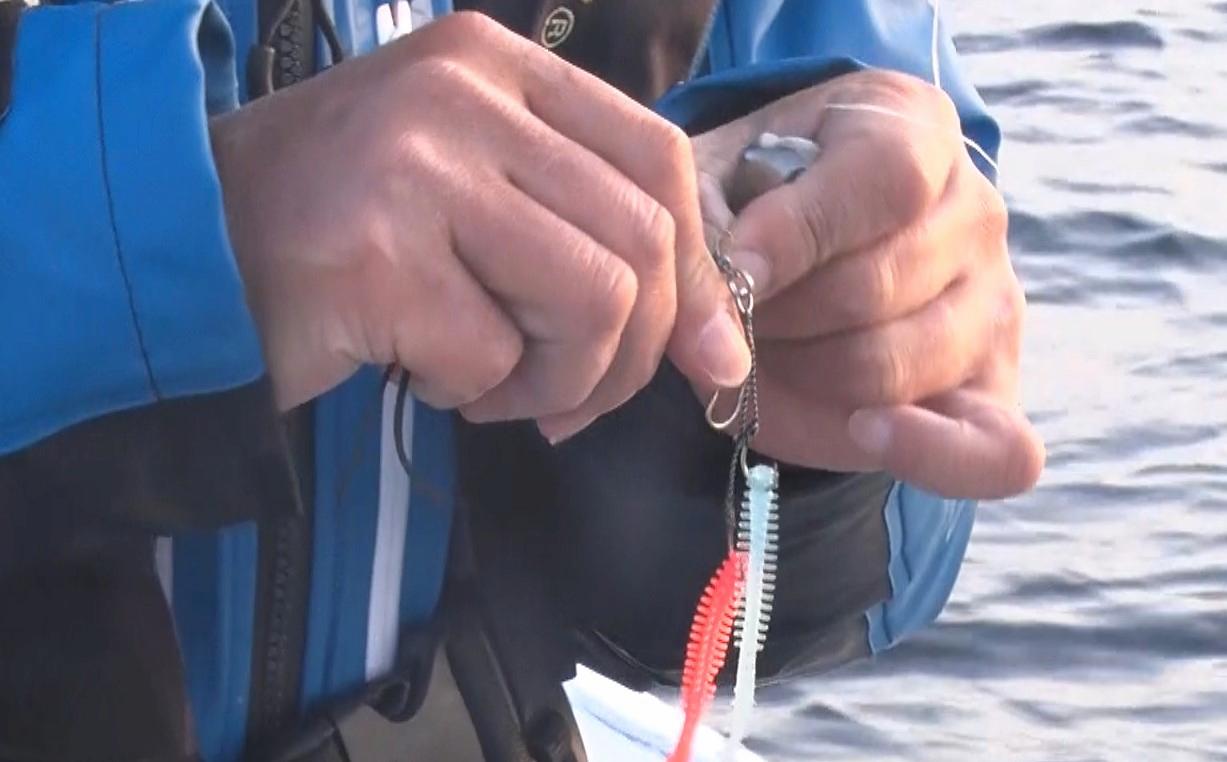
After the sun came out completely and we moved to a new point, Ayuchii was the first one to hit the water. It was a Lenko-Dai, but I was happy to catch it even if it was not the main target, a red snapper. In the morning, it was a rush of red snapper.

After that, Mr. Naka finally got a long-awaited fish that showed a strong pull. Enjoying the pull, he floated it on the surface of the sea, and it was a good-sized red sea bream of his main target, the nokkomi-nokkomi. Mr. Naka changed his tie to Silhouette Black and UMIKEMUSHI Curly to black as the amount of light rays increased, and his silhouette-conscious setup successfully led to the bite. The easy tie change with the “Click Tailor” was a great success.
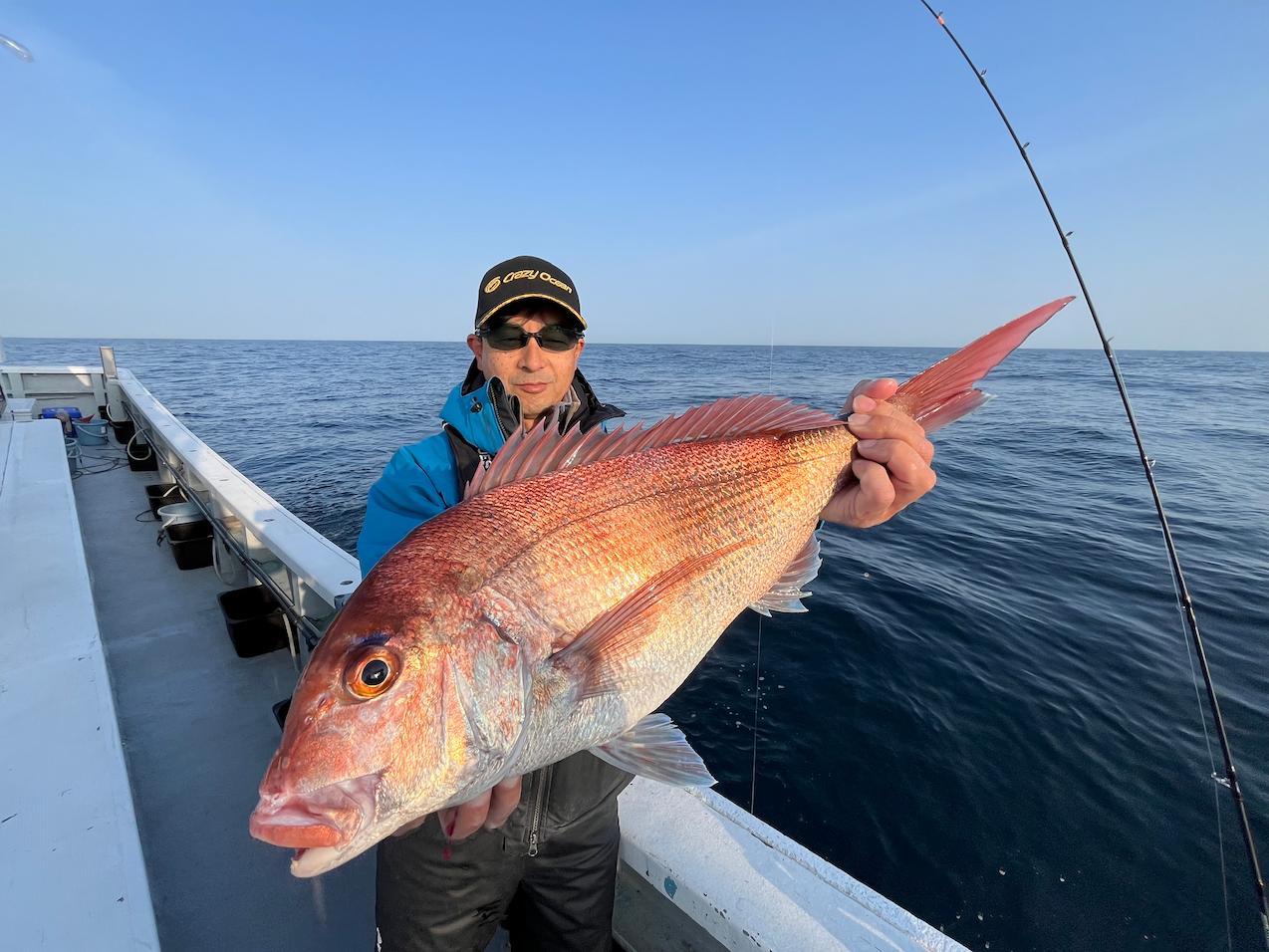

TAIRABA product information
https://crazy-ocean.com/itemlist/カチッとタイラバシリーズ
Strong wave action appeals to bigeye snapper
The main target this time is the bigeye snapper, which are preparing to spawn and aggressively feeding on bait. The more volume in the setting of a tilefish bait, the better,” explains Mr. Naka. Therefore, the main pattern for this fishing trip was to attach two trailer worms, the Umi Hairy Curly. The members aboard the boat changed the color combination of each worm to see how they fared. Incidentally, the UMIKEMUSHI CURLY has a finely ribbed body that produces waves while the tail generates waves different from the body for intense appeal. The tie, the body of the UMIKEMUSHI, and the tail of the UMIKEMUSHI all move in different ways to appeal to large sea bream with the different rhythms of the tie’s thin wave action and the strong wave action of the sea caterpillar.

UMIKEMUSHI CURLY Product Information
https://crazy-ocean.com/itemlist/海毛虫curly
Mr. Naka dared to change the head to a heavier 200g head in order to change the fall speed. It worked, and Mr. Naka got another hit. The fish, which took a bite 5 meters from the bottom, was a red sea bream one size larger than the previous one. The fish took a bite on a tie-rabber set with a silhouette black tie, UMIKEMUSHI CURLY brown bumblebee color and cream soda BL glow color. Sometimes it is better to drop the tilefish more lightly and more slowly as far as it can land, while other times a fast fall is better. The slower fall can make the angler aware of the tilefish’s presence, but sometimes it can also make the angler aware of the chasing sea bass. However, sometimes the chasing red sea bream may flip over in the middle of the fall. On the other hand, a fast fall can induce reaction bites from active snapper. Since it is impossible to say which is better than the other, experimenting with different methods is the shortest way to get the best results.

An additional hit by a high-end fish
Finally, a fish that seemed to be a good size hit AYUCHII as well. However, this one did not show the same pulling force as a snapper. Even the person who was reeling in the fish said, “What is this fish? What is this fish? I was in a state like that. After reeling it in slowly, a good-sized amadai appeared on the surface of the water. The angler himself was surprised. He was quite happy to have a guest. Following Ayuchii, Mr. Ota’s electric tilefish also hit. It was also a good-sized ama-dai.
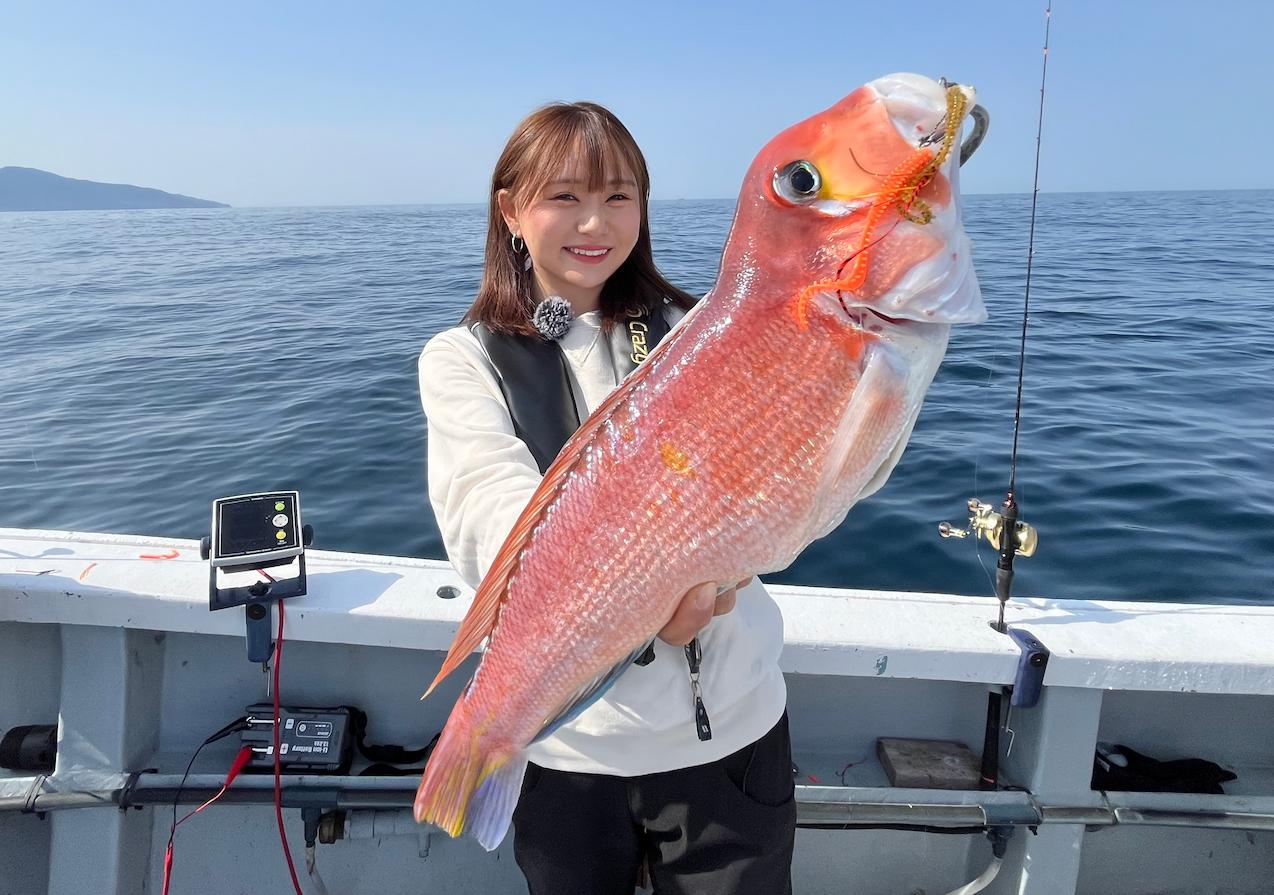
A nice guest, a red sea bream. And it was a good size. It was a hit on the sea caterpillar Curly’s brown bumblebee and bright orange color!
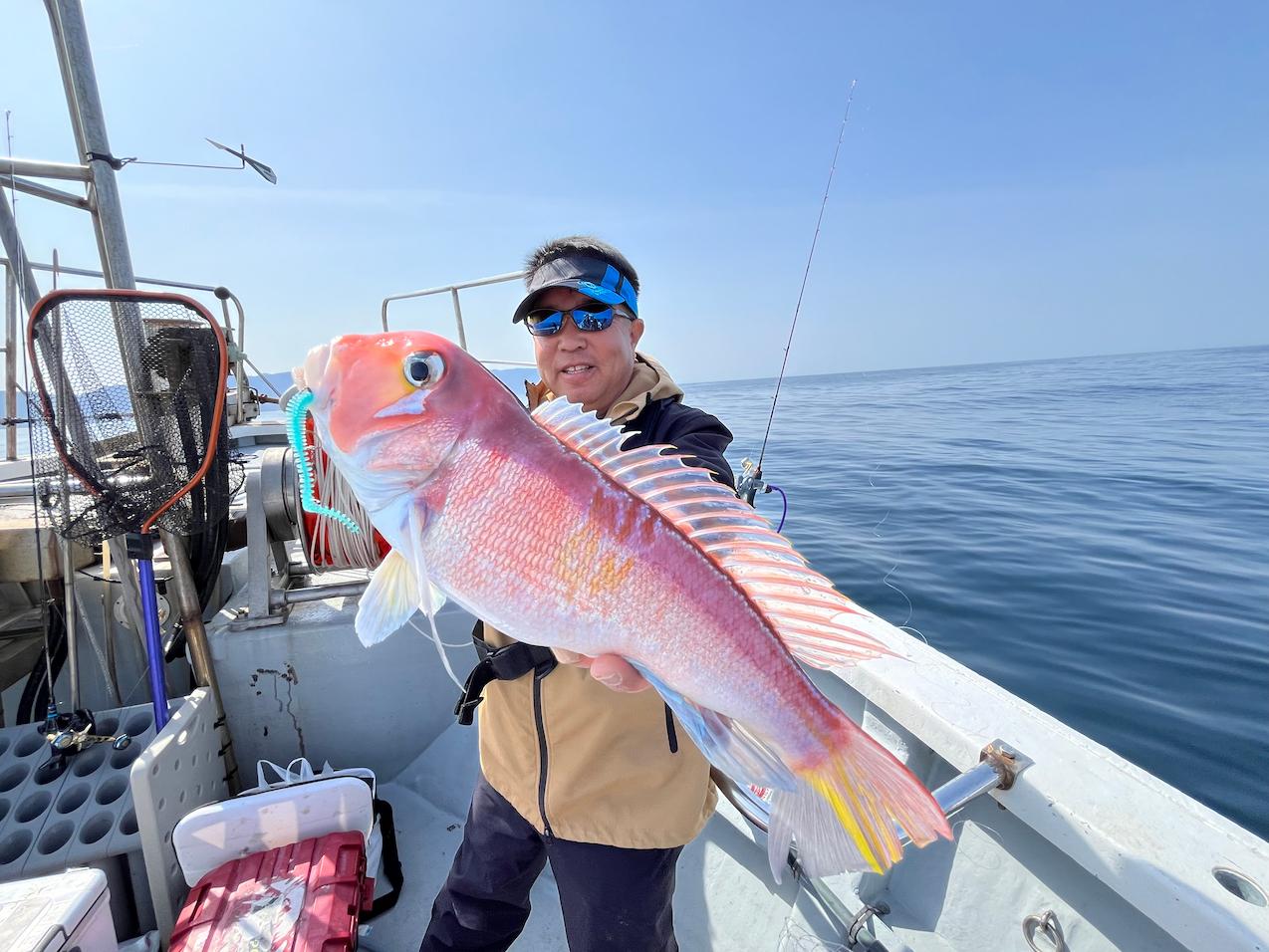
Mr. Ota also got a hit with an ama-dai. He was wearing Cream Soda BL Glow color of Sea Caterpillar Curly.
Then, as if the amadai hit was the best time of the day, Mr. Naka got another hit. The pull was immediately recognizable as a red sea bream. The Rod Ocean Sensor Tie-Laber bent beautifully and absorbed the unique pull of the red sea bream. Ocean Sensor Tie-Lava is a model with a show and length that is easy to handle and has a good bite tone, so that anglers can enjoy the bending of the rod after hooking the fish. The flexible bending of the rod prevents anglers from being caught.
The biggest sea bream of the day was the one that safely rose to the surface. Later, Mr. Tsui, who knows the waters of Fukui very well, also had a big one hit on his electric tie-laba. He said that the hit was made at 7 meters from the bottom.
Ocean Sensor Tie-Laber Product Information
https://crazy-ocean.com/itemlist/オーシャンセンサータイラバ
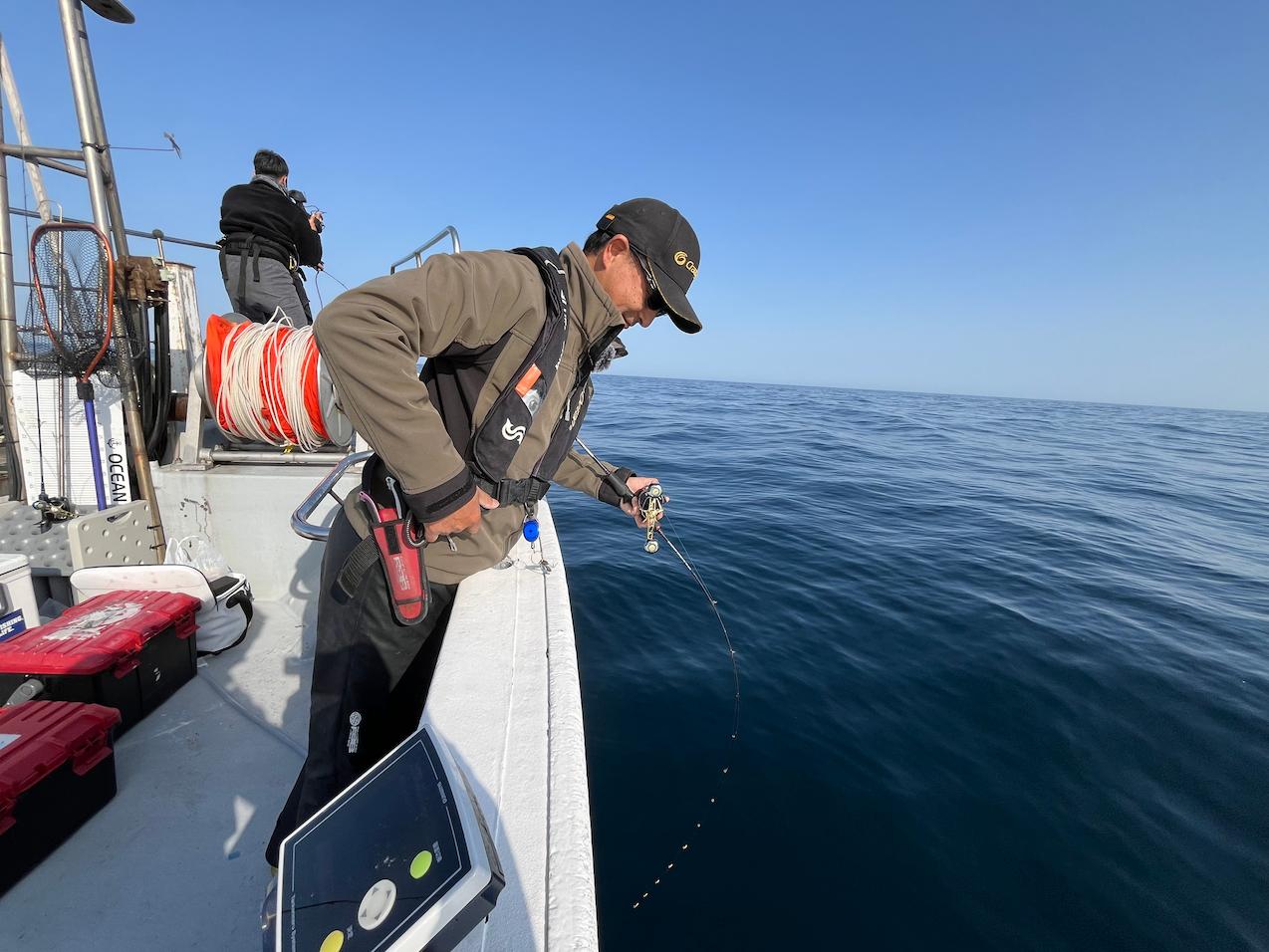

A tie-laba set with the sea caterpillar curly brown bee, cream soda – BL glow color, hit! It’s a satisfying size.

Another hit for Mr. Tsui. He set up Umi Caterpillar Curly in orange gold and clear purple lame color.
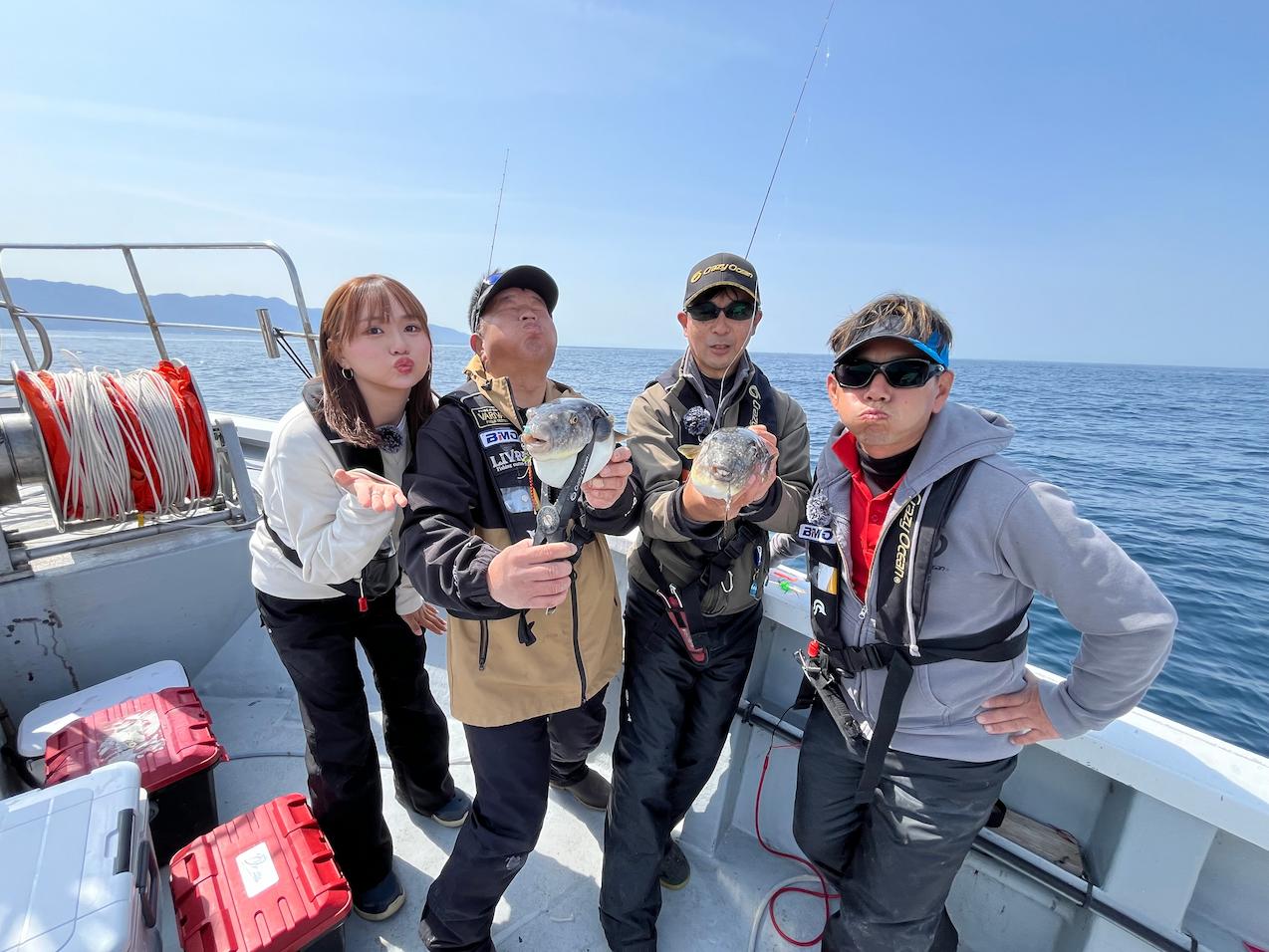
Finally, we had a series of hits of Muffugu. It was an enjoyable fishing trip.
This time, we caught a good size snapper and a variety of tasty fish, and everyone was satisfied. Among them, Mr. Naka caught 3 big sea bream. The reason for this was the change of tie-ruba items. He frequently changed the color of his tie, the color of his UMIKEMUSHI worm trailer, and the weight of the head to find the right pattern. One of the pleasures of tie king mackerel is to think of such a pattern, change it, and search for it. The easy-to-replace “click” tie-laba is the perfect tool for this kind of fishing. By preparing various types and weights of heads, ties, and tie-rubber trailers (such as the UMIKEMUSHI CURLY) in a variety of colors, you will be able to expand the scope of your fishing strategy.
The captain of Ocean Queen says, “May is the best time of year to fish for red sea bream and other tasty fish, so be sure to visit. If you are interested, please check it out and give it a try.

For the video of the day, click here
https://locipo.jp/creative/86f94246-51f8-483e-9eaf-32d9ea34d5e6?list=a24f93b1-4ad9-4b27-ad1a-7dddbb1a8586
For the program information on Fishing Lover Tokai, please visit
https://fishinglover-tokai.com/
Fishing boat
OCEAN QUEEN Captain Yusuke Tsuruta
https://www.o-queen.com/


